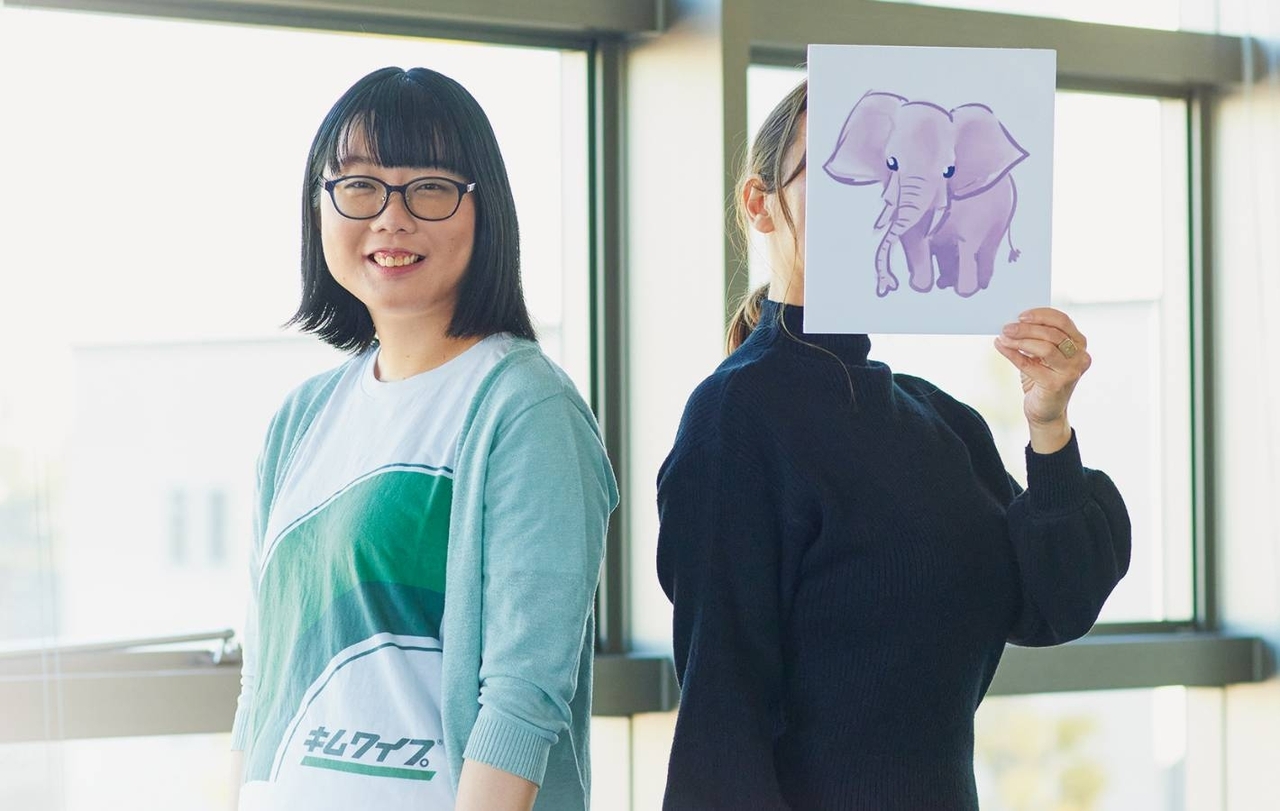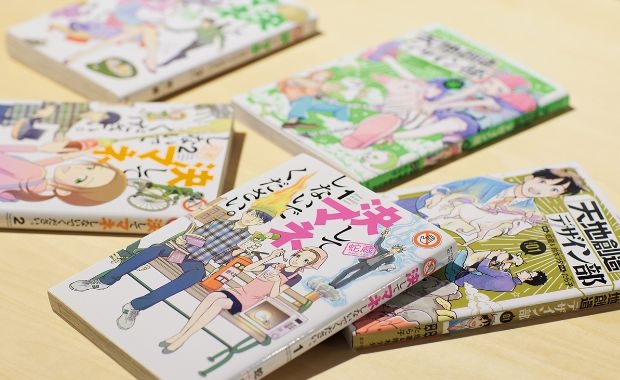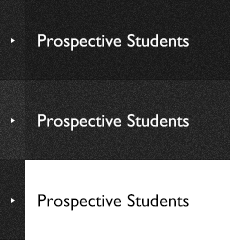Stories born from the space between fantasy and reality
Yoshimi Takuwa, Lecturer, Future of Humanity Research Center, Institute for Liberal Arts and Hebizo, copywriter, manga artist, original author

Hebizo creates manga on various themes, including science. Yoshimi Takuwa is a lecturer who conducts research on the history of science. The two have teamed up as manga artist and editorial supervisor to create works that interweave unique fantasy and real knowledge. How do these creators use their respective expertise to produce stories that resonate with a wide readership? This dialogue provides a behind-the-scenes glimpse of their creations.
Two people fascinated by the depth of scientific history - Infinite possibilities expanding through co-creation
Takuwa: History of science is the study of how various scientific concepts, experimental methods, and other matter related to science have changed historically. I was fascinated by the life of Isaac Newton and his experiments with light. Acting upon this interest, I first earned my bachelor's degree in physics, and then began to study history of science in earnest upon entering the master's program. I started supervising manga when the research lab where I used to work received a request from Hebizo. Hebizo, you incorporate a wide variety of themes into your work. What made you particularly interested in scientific history?
Hebizo: My interest was sparked when I read a novel that my friend had recommended. It was about researchers who laid the foundations of science and technology. I was shocked to learn that the everyday life which we take for granted is supported by the extraordinary hard work and discoveries of scientists, and I wanted to create a manga depicting the drama surrounding these researchers. That said, biographies are frequently overly-dramatized by later generations. I felt the need for expert guidance to prevent me from confusing historical facts with legends. When I visited a Tokyo Tech professor and inquired about editorial supervision for my project, I was introduced to Dr. Takuwa.
Takuwa:The first manga that I was involved in was Kesshite Mane Shinaide Kudasai (Please Do Not Attempt, Ever). This manga covers numerous scientists and their achievements, and I spent days reading through materials in order to supervise its production. The next project I supervised was Tenchi Sozo Dezain-bu (Heaven's Design Team). This manga focused on biology topics, so I had to investigate matters beyond my expertise. For example, I read about long-necked dinosaurs to see what would happen if a giraffe's neck were stretched even further. It was a novel and irreplaceable experience to venture into unknown territory together with Hebizo's story.
*1 Points to convince the readers
During supervision of the manga, Takuwa not only corrected mistakes, but also provided relevant information that should be noted, although it may have appeared superfluous. Takuwa's sharing of her knowledge in advance allowed the author to use her own understanding to accurately answer any questions from the readers. This supports the credibility of the story.

Hebizo:Manga must allow for inadequate explanations because it prioritizes ease of understanding for the reader. There were many aspects of my story that went against the intentions of experts. After taking these circumstances into consideration, Dr. Takuwa carefully explained such mistakes and related reasons. She then offered a number of alternatives to make the story work. She also raised accurate points*1 word-by-word. I was surprised by her attention to detail that goes beyond her field of research. One episode which had a particularly strong impression on me occurred when a centaur was featured in Heaven's Design Team. The following question was raised as part of the manga: "A centaur has both the body of a human and a horse, and should therefore have two sets of ribs. In which set should the internal organs such as the heart be placed?" In response, Dr. Takuwa raised the following correction: "The heart is a circulatory organ and should not be referred to as naizo." (Naizo, the Japanese word for internal organs, does not include the circulatory and nervous systems.) I was impressed by her attitude of thoroughly investigating even the smallest details.
Takuwa:Of course, in my role as editorial supervisor, I did my best to make the story persuasive. During this process, I faced a barrier in terms of scientific communication. Using scientific terminology at a junior high school level to explain specialized knowledge such as theory of relativity and quantum mechanics requires a lot of effort. I remember one time when I sent a hand-written formula for the manga. The printers nearly printed "ρ" as the similar letter "p" because they weren't familiar with how Greek letters are used to represent physical quantities. Normally, I hadn't paid much attention to my interactions with science and engineering students. However, through my exchanges with Hebizo, I was able to explore ways of communicating with people who are unfamiliar with scientific expertise or conventions.
Interesting stories and accurate knowledge - Delivering works which combine both for the reader

Hebizo:Creativity and research are fields where ideas and uniqueness are often strong points. Dr. Takuwa, how do you incorporate your unique personality into your research?
Takuwa:The majority of research in the history of science is conducted using historical methods that refer to written materials such as notebooks on experiments and academic conference records of the time. However, relying on such materials alone makes it impossible to discover things which were not put in writing. For example, the theory and experiment results may not have matched, or the experiment itself may have failed. Therefore, I replicate experiments as a means of understanding the trial-and-error process that is not found in literature. For example, Galileo Galilei proposed the law of free fall which states that the speed of falling is the same regardless of the weight of the object. Galileo is said to have proved this theory by dropping two balls of different weights from the Leaning Tower of Pisa. In his experiment, both balls are said to have hit the ground at the same time. However, if you replicated the same experiment, you will find that the heavier ball hits the ground first due to air resistance. In this way, historical experiment results are often reconstructed to match the claimed theory. I enjoy learning new facts which have to be deduced. It also allows me to utilize my experience from conducting experiments in the physics department during my university days.
Hebizo:The attitude of finding a niche area where you can demonstrate your strengths is also applicable to the production of manga. On the other hand, the difficult part of entertainment is the need not only for originality but also for the appeal of "classic" stories with which many readers can sympathize. While applying my standard of whether or not I find something interesting, I also observe the reactions of people around me to help me during times of indecision.
Takuwa:I teach history of science in the liberal arts. I feel that it is important to make students recognize interesting aspects in order to motivate students to study seriously. Therefore, at the beginning of each class, I pose questions such as "Did Galileo Galilei really say 'And yet it moves' in reference to the Earth?" and "Why do Japanese people think that the rainbow has seven colors?" I then provide explanations based on historical materials. If students recognize the surprising facts behind the discourse that was assumed to be common knowledge, they will be motivated to learn.
*2 The "formula" of interesting works
When watching movies and other works, I thoroughly analyze what makes them interesting. I take detailed notes on aspects such as the time allotted for introducing plots and introducing characters, and the timing allotted for foreshadowing. Finding the "formula" of works that are loved by the public and replacing elements of the formula with unique values is essential for creating attractive works.

Hebizo:The desire to introduce interesting aspects which people usually overlook is the driving force behind my creation. In order to convert my ideas into manga that grabs the reader's attention in the first four pages, I have to use various methods, such as incorporating the formula*2 that is common to popular works. I pay particular attention to the balance between entertainment and fact, striving for moderate dramatization which does not mislead the reader.
Takuwa:I feel that all of Hebizo's works feature an exquisite balance of interesting stories and accurate knowledge. Up until now, I have been helping to disseminate information as an editorial supervisor for manga. However, in the future, I intend to publish a book that conveys the appeal of Newton's life and experiments. While utilizing what I learned through collaboration with Hebizo, I would like to create my own standard that links both interest and accuracy.
The key to conveying the appeal of learning is combining the strengths of manga artists and experts
Takuwa:While serving as editorial supervisor, I was impressed by Hebizo's desire to understand areas beyond her own knowledge and experience, and as well as her respect for the opinions of experts. Moreover, each one of her works has detailed supplements to items introduced in each story. This shows Hebizo's respect for specialized fields. For example, Kesshite Mane Shinaide Kudasai (Please Do Not Attempt, Ever) is accompanied by footnotes and references, as well as special interviews which introduce comments by researchers. In Tenchi Sozo Dezain-bu (Heaven's Design Team), the detailed ecology of the creatures introduced in the manga is summarized in an "Encyclopedia of Living Things." You are adept at stimulating the reader's interest and guiding them to more accurate knowledge.
Hebizo:Thank you very much for saying so. I create manga with the intention of opening a peephole into the so-called "ivory tower;" that is, the space where experts devote themselves to academic research. Everyone can see the view through the peephole. However, we mustn't be fooled into thinking that we see the whole picture. Therefore, in my work, I try to highlight unique cases that draw people's attention, while also showing the paths that lead to specialized knowledge. It is important to convey to the reader the profound fascination of learning while still adhering to the premise.
*3 Relatable sci-tech episodes

This manga is filled with small jokes that will not only resonate with students with specialized knowledge in science and technology, but will also amuse other readers. The t-shirt worn by Takuwa incorporates the package design of the industrial wipers "Kimwipes " (produced by Nippon Paper Crecia), used for wiping laboratory equipment. The same t-shirt is also worn by characters in the manga.
Takuwa:When I learned that a manga about scientific history would be produced, I was actually worried about whether it would be interesting to general readers. However, after supervising Kesshite Mane Shinaide Kudasai (Please Do Not Attempt, Ever), I realized that my worries were unfounded. This manga features a dual structure depicting the daily life of science and technology students and the episodes of scientists told therein. This structure makes it enjoyable for everyone regardless of knowledge. I realized that the "relatable episodes of science and technology"*3, which I had thought would be rejected by readers, were depicted in an interesting way and loved by a wide range of readers. It was also an opportunity to experience the splendor of student life at Tokyo Tech.
Hebizo:I'm so happy to hear you say that, because my goal was to convey the interesting aspects of daily life by students at Tokyo Tech. My lifelong theme is to transform learning into entertainment. In order to spread the appeal of learning to many people, I will continue to work on manga production with a focus on elements such as media franchising. For that reason, it is essential to have cooperation from editorial supervisors with scientific expertise like Dr. Takuwa. Besides manga, there are many other works in the entertainment industry that require expert knowledge. In addition to research and educational activities, it would be nice if supervision was added to the job options.
Takuwa:I have also broadened my interests through works depicting scientists and their history, so I strongly feel the importance of entertainment. Experts can provide detailed explanations of research fields. However, in order to make a story accessible for everyone to enjoy, the cooperation of creators such as manga artists and original authors is indispensable. In order to expand the base of science, I hope that the scope of collaboration will grow even further in the future.
There's more! Growing intellectual curiosity

Rainbow
The expression "seven-colored rainbow," which is common in Japan, is influenced by Newton's theory. Newton claimed that shining white light (sunlight) through a prism would disperse it and divide it into seven primary colors. However, when replicating Newton's experiments, the color of the dispersed light changes continuously. This makes it difficult to clearly distinguish the seven colors. A closer look at experimental results reveals that the theories and proofs that we learn in school are surprisingly complex.

Dialogue
Character dialogue is important to convey expertise in an easy-to-understand manner. One trick is to use impactful metaphors and expressions within a range that is not far from the facts. For example, when introducing Isaac Newton, it is easier to get a certain amount of interest from readers by presenting him as a narrow-minded recluse. However, when using expressions that not everyone will understand, it is also necessary to consider my target and choose my words appropriately.

"Achievements of scientists who support everyday life from behind the scenes. By relying on the knowledge of experts, I create manga that shows the paths of scientists to my readers."
Hebizo
copywriter, manga artist, original author (former part-time lecturer at Tokyo Institute of Technology)
After working as a copywriter at a video game company, Hebizo went independent. Her comic essay Nihonjin no Shiranai Nihongo (The Japanese that the Japanese Don't Know) (Hebizo/Nagiko Umino, Kadokawa) became a bestseller. Her manga Kesshite Mane Shinaide Kudasai (Please Do Not Attempt, Ever) (Hebizo, Kodansha), which was based on Tokyo Tech, was adapted into a TV drama on NHK General TV in 2019. Tenchi Sozo Dezain-bu (Heaven's Design Team) (Hebizo/Tsuta Suzuki/Tarako, Kodansha) was adapted into an anime in 2021.

"I was fascinated by the experiments and lives of scientists, so I embarked on the path of research. Supervising manga projects has allowed me to discover various new fields and expand my interests."
Yoshimi Takuwa
Associate Professor (Lecturer)
Future of Humanity Research Center, Institute for Liberal Arts
Tokyo Institute of Technology
Completed her Ph.D. at the Graduate School of Decision Science and Technology, Tokyo Institute of Technology. Her specialty is history of science. In particular, she has extensive knowledge on the history of physics. She has also supervised and supported the production of numerous manga and TV programs.
The Special Topics component of the Tokyo Tech Website shines a spotlight on recent developments in research and education, achievements of its community members, and special events and news from the Institute.
Past features can be viewed in the Special Topics Gallery.
(Interview held on December 15, 2022 at Ookayama Campus)
. Any information published on this site will be valid in relation to Science Tokyo.












